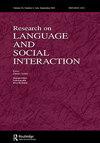用范畴维护Murrinhpatha-Speaking儿童语言中的权威
IF 2.1
1区 文学
Q1 COMMUNICATION
引用次数: 0
摘要
摘要儿童和一般的演讲者一样,经常使用人、地点和活动类别(如医生、学校、就寝时间)来构建和监控他们之间的互动。本文探讨了澳大利亚北部Wadeye的一群讲Murrinhpatha语的土著儿童在试图维护权威时使用的类别。权力不对称的产生和协商是世界各地儿童同伴谈话的一个共同特征,但在这里,这是第一次在使用传统澳大利亚语言的人中进行分析。分析表明,尽管与其他社会文化/语言背景下的儿童有相似之处,但这些儿童对成员类别的选择(例如,丈夫、国家)以及他们如何部署和应对这些类别(例如,分别通过模糊和沉默)存在差异。这些差异突出了语言、社会和演讲者可用的互动资源之间的联系,并强化了在儿童演讲中研究成员分类的优点。Murrinhpatha数据及英文翻译。本文章由计算机程序翻译,如有差异,请以英文原文为准。
Using Categories to Assert Authority in Murrinhpatha-Speaking Children’s Talk
ABSTRACT Children, like speakers more generally, often use categories of person, place, and activity (e.g., doctor, school, bedtime) to frame and monitor interactions among themselves. This article explores the use of categories by a group of Murrinhpatha-speaking Aboriginal children in Wadeye, northern Australia, when attempting to assert authority. The creation and negotiation of power asymmetries are a common feature of children’s peer talk worldwide but analyzed here for the first time among speakers of a traditional Australian language. Analysis suggests that although there are similarities with children from other sociocultural/linguistic contexts, there are differences in these children’s choice of membership categories (e.g., husband, country) and how they deploy and react to them (e.g., by ambiguity and by silence respectively). Such differences highlight the connection between language, society, and the interactional resources available to speakers as well as reinforcing the merit of studying membership categorization in children’s talk. Data in Murrinhpatha with English translation.
求助全文
通过发布文献求助,成功后即可免费获取论文全文。
去求助
来源期刊
CiteScore
7.30
自引率
7.40%
发文量
20
期刊介绍:
The journal publishes the highest quality empirical and theoretical research bearing on language as it is used in interaction. Researchers in communication, discourse analysis, conversation analysis, linguistic anthropology and ethnography are likely to be the most active contributors, but we welcome submission of articles from the broad range of interaction researchers. Published papers will normally involve the close analysis of naturally-occurring interaction. The journal is also open to theoretical essays, and to quantitative studies where these are tied closely to the results of naturalistic observation.

 求助内容:
求助内容: 应助结果提醒方式:
应助结果提醒方式:


